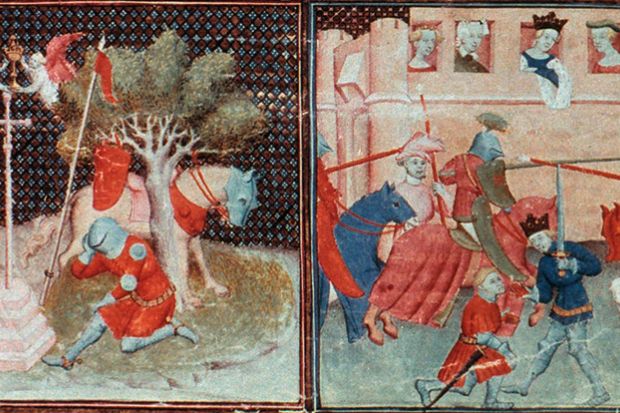In this stimulating study of medieval French Arthurian romance (with a bit of Narnia and Harry Potter thrown in to broaden the appeal), Karen Sullivan asks some challenging questions about the truth claims of romantic fiction. Can romance, regularly dismissed by medieval and modern critics as dangerous escapism, give us access to truth? And, if so, what truths does it reveal?
The book’s argument is themed around the major characters of Arthurian romance, Merlin, Lancelot and Arthur, each of whom represents a challenge to established belief while offering their own versions of the truths of human experience.
Both madman and prophet, Merlin defied the known laws of nature with his supernatural gifts, eliciting a damning response from writers such as William of Newburgh and John of Salisbury. But in some of the romances, Merlin is given the authority of the expert, the man who knows how things work and to whom kings listen for advice.
Lancelot was denounced for his adultery, which flew in the face of medieval morality, but what saves his reputation, argues Sullivan, is his essential goodness in both love and war. In a fallen world, he upholds his own values and is therefore the best kind of man that can be envisaged.
King Arthur himself stands at the crossroads of history and fiction, embodying both and thus problematising medieval theories of historical reality. Even sceptics such as William of Malmesbury never doubted that Arthur was a real historical king; what they objected to were the “fictional embellishments” that corrupted the true story. Arthur’s disappearance to Avalon, the death that is not a death, undermines the possibility of an absolute distinction between history and fiction.
The single most important truth, for medieval writers, was the pre-eminence of God, a theme that links the medieval Grail quest with C. S. Lewis’ Narnia books. In her chapter on the 13th-century Queste del Saint Graal, Sullivan argues that, in defiance of clerical disapproval, the Grail knights achieve a profound understanding of the reality of their worldly lives through their quest for sacred objects. Despite the irresolvable ambiguity of the symbolism of the Grail legends in their many forms, there is a core of historical reality at their heart – debates about the Eucharist and the importance of Holy Communion – which connects the fantasies of the Grail to a contemporary spiritual reality.
Rich in argument and engagement, the book is less strong on the particular truths to which romance offers us a pathway, implying an outdated anti-theory along the lines of “a text can mean whatever you want it to mean”. The refusal to discuss romance in the context of “literary” and “popular” discourses, despite the choice of texts from both categories, starves the book of a meaningful analysis of how truth and reality are constructs produced for different audiences.
The strength of the book lies in Sullivan’s enviable knowledge of the key texts of Latin learning, from Aristotle to Augustine and Aquinas, and her sure grasp of medieval concepts of epistemology and perception, truth and fantasy. From this base, she convincingly rebuts critical responses to romance as a dangerous form of self-delusion distracting its readers from the truths of the world.
Helen Fulton is professor of medieval literature at the University of Bristol and the co-editor of Anglo-Italian Cultural Relations in the Later Middle Ages (2018).
The Danger of Romance: Truth, Fantasy, and Arthurian Fictions
By Karen Sullivan
University of Chicago Press
336pp, £26.50
ISBN 9780226540269
Publication 10 April 2018
POSTSCRIPT:
Print headline: Love, and enlightenment, actually
Register to continue
Why register?
- Registration is free and only takes a moment
- Once registered, you can read 3 articles a month
- Sign up for our newsletter
Subscribe
Or subscribe for unlimited access to:
- Unlimited access to news, views, insights & reviews
- Digital editions
- Digital access to THE’s university and college rankings analysis
Already registered or a current subscriber?










